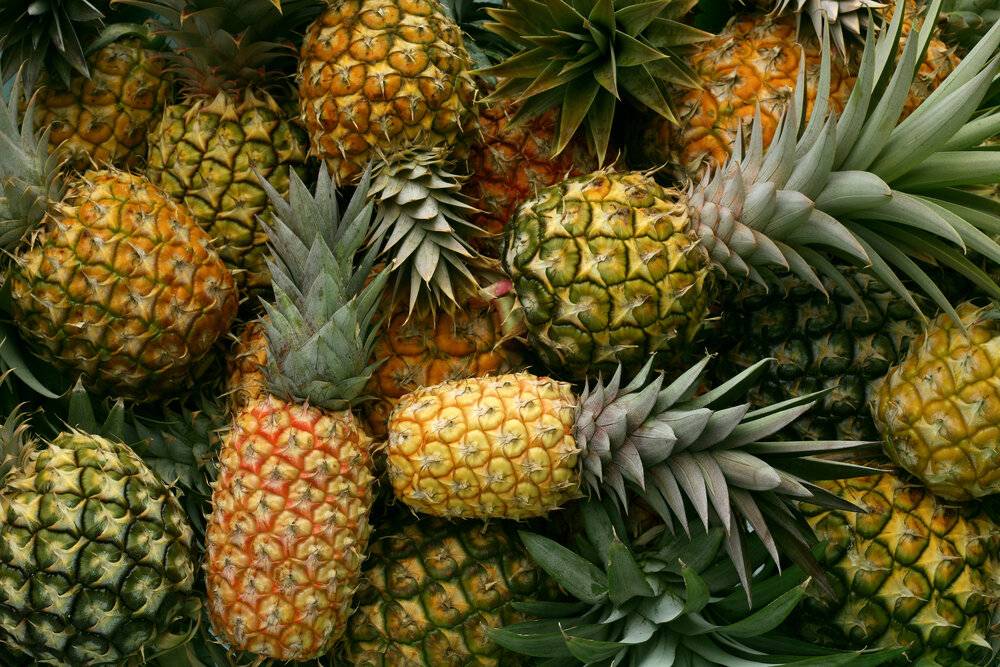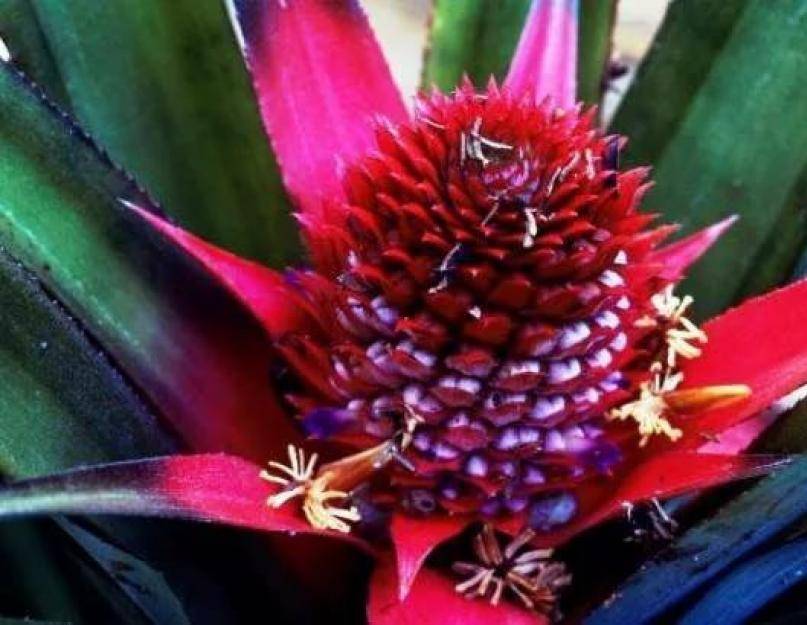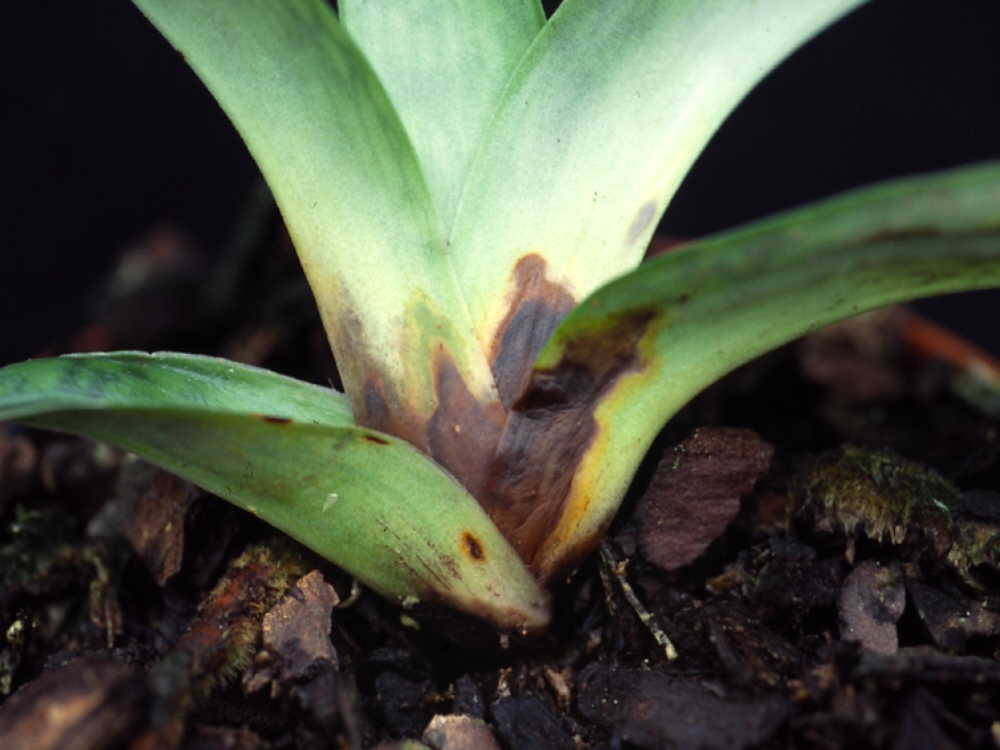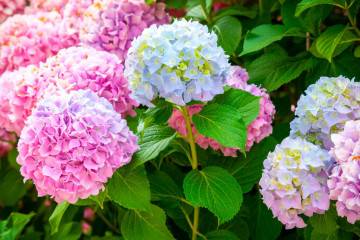How pineapple grows in nature and at home
Content:
Pineapple is an exotic plant famous for its delicious fruit. It contains a large amount of useful substances, so it is used not only for use as a dessert, but also as a remedy. It is easy to grow pineapple at home on your own, the main thing is to purchase high-quality planting material. The article provides information on how to plant a pineapple, how to care for it, as well as possible problems when growing exotic plants.
What is this plant
Pineapple belongs to the Bromiliev family. This plant is native to the tropics of South America, from where it then spread throughout Europe. It is the only plant in its family that produces edible fruits. The main producer and transporter of exotics is Brazil.
Description
Pineapple is a herbaceous shrub 60-100 cm high. There is no main stem, narrow leaves are collected in a rosette. The sheet plates are very strong due to the large amount of fibers. The roots are poorly developed. A flower arrow about 50 cm long grows from the middle of the bush.
How does pineapple bloom? Its inflorescence consists of many flowers. Within 3 weeks, they bloom in turn, then mini-fruits are formed from them. As the fruit grows, it grows together, forming a compound fruit that looks like a golden brown bump. A dense green crest peeps out from the top.
Beneficial features
The fruit of the pineapple tree is not only delicious, but also healthy. It contains a large amount of vitamins, trace elements, essential acids, bioflavonoids. Due to this, pineapple brings the following benefits to the body:
- cleanses the gastrointestinal tract of toxins;
- speeds up metabolism;
- reduces pressure;
- promotes weight loss;
- reduces blood viscosity;
- removes excess fluid from tissues.
How to grow pineapple at home from the top step by step
The most important rule when growing pineapple from the top is to choose a quality fruit. The development of the outlet depends on this. If a florist, before growing a pineapple from the top, familiarizes himself with the rules of planting and care, he will be able to avoid many problems.
Pineapple selection for planting material
For planting, choose a pineapple with a rosette of leaves on top. They should be solid gray-green in color. A quality fruit has a moderately firm flesh and a yellow-brown skin. You need to pay attention so that the pineapple is not frozen, otherwise it will not be able to take root.
Top preparation
You can try to pull out the leaf outlet by hand. If it doesn't work, take a knife and carefully cut the top off at a 45 ° angle.The depth of the cut should be small: it is enough to capture 1-2 cm of the fruit. And even, on the contrary, the excess pulp must be removed, as it may begin to rot.
The lower leaves are removed to a height of 2 cm. Then the crown is left to dry for a week.
Apex rooting procedure
The leaf outlet must first be germinated: for this, it is placed in a glass with warm, settled water. The liquid should not cover the stem too high. To prevent acidification of water, you need to change it every 2-3 days. After about 3 weeks, roots will appear on the cut.
Planting the germinated tip
After the formation of the root system, the outlet can be planted in a container. The procedure is performed as follows:
- Drainage from small stones or expanded clay is laid out at the bottom of the container.
- Then light fertile soil is poured. A small depression is made in the middle, into which a rooted rosette is planted.
- Pineapple is covered with earth, which is then lightly tamped.
- The top is watered. From above it can be covered with a film to create the necessary microclimate.
- The pot with the plant is placed in a warm, well-lit place.
Conditions for growing indoor pineapple
In order for the plant to develop quickly and look spectacular, it needs to be provided with the required conditions. How the pineapple grows determines its further decorative appearance.
Illumination and temperature conditions
Pineapple loves good lighting, so it is displayed on the southern windowsill. In summer, the plant pot can be placed on the balcony, terrace or taken out into the garden. You cannot turn it over, so the place for the flower is chosen immediately. In winter, the palm tree is additionally illuminated with special lamps.
The most comfortable temperature for a plant is 22-25 ° C. Therefore, in winter it is placed in the warmest room. If pineapple is grown on a windowsill, it is protected from drafts.
Watering rules and humidity
The culture does not like abundant watering: it is enough to water the outlet once a week. The water should not stagnate, so excess water from the sump after 10-15 minutes. drained. If the ground begins to smell like a swamp, ananas need to be urgently transplanted into new soil and watering should be reduced.
You can add a few drops of lemon to the water. Instead of irrigating the land, some growers water the plant through a socket outlet.
Top dressing and soil quality
For the plant, land is purchased for cacti, since it is loose, light, contains all the necessary components. From March to the end of September, the culture is fed once every 2 weeks. For this, mineral fertilizers are used for bromilium. The main condition: the top dressing should not contain copper and boron, which negatively affect the pineapple.
Flower container size
The root system of the plant is shallow, so the pot is selected wide with a height of no more than 14-15 cm. Such dishes contribute to good aeration of the soil. In a pot with a wild exotic, there must be a hole to drain the water, otherwise pathogenic microorganisms may appear in the ground.
Flowering pineapple
About 1.5 years after planting the rosette, the pineapple begins to bloom. From the middle of the bush, an inflorescence appears, consisting of many flowers of raspberry, purple or lilac color. After flowering, ovaries are formed, which, growing, merge into one large, rough fruit.
Propagating homemade pineapple seeds
Exot can be propagated by seeds, which are purchased at a flower shop. The seeds are washed in a weak solution of potassium permanganate and dried. Landing is done as follows:
- A mixture of leafy earth, peat, sand is poured into the box.
- The seeds are buried in the ground by 2 cm.
- Slightly moisturize the soil.
- The box with the landings is covered with foil.
The container is placed in a warm place. The higher the air temperature, the faster the seeds will germinate. Seedlings appear unevenly, the process can take 7-8 months.
Growing problems, diseases and pests
The indoor pineapple owner may face the following problems:
- the lower leaves dry up and curl. This is most likely due to the growing of the plant in a draft. It must be rearranged in a warm, windy place;
- slow development. A possible reason is a lack of nutrients in the soil. Fertilizer for bromylium crops is recommended;
- leaves dry up and fall. Pineapple is thermophilic, but you should not expose it to the hot rays of the sun. When keeping the plant outdoors in summer at noon, it must be shaded;
- brown dots appeared on the leaves. These pests are scale insects. They are easily washed off the leaf plates with a swab dipped in soapy water;
- leaf plates were covered with brown spots. This means that the plant has been affected by fungus due to over-watering. The affected parts need to be cut out, the pineapple should be transplanted into a pot with new soil.
Every florist can try to grow pineapple at home from the top. To do this, you need to carefully unscrew it, dry it, plant it in a pot with loose earth. It is necessary to properly care for the plant: put it in a well-lit place, which does not get the sun's rays, periodically water it, feed it. And then soon the pineapple will begin its development and maybe even bloom.





















